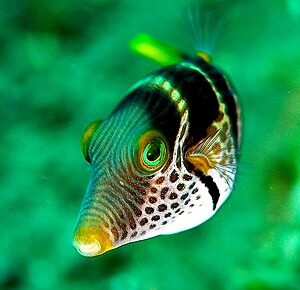Valentin's sharpnose puffer facts for kids
Quick facts for kids Valentin's sharpnose puffer |
|
|---|---|
 |
|
| Conservation status | |
| Scientific classification | |
| Genus: |
Canthigaster
|
| Species: |
valentini
|
The Valentin's sharpnose puffer (Canthigaster valentini) is also known as the saddled puffer or black saddled toby. This small fish lives in the ocean, usually near the bottom, and belongs to the family called Tetraodontidae, which includes all pufferfish.
The saddled puffer is a small fish, growing up to about 11 centimeters (4.3 inches) long. You can find it in warm, tropical, and subtropical waters across the Indian Ocean (including the Red Sea) and all the way to the islands of the Pacific Ocean. It likes to live around rocky areas and coral reefs, in calm lagoons, and on the outer parts of reefs, sometimes as deep as 55 meters (180 feet). These fish are active during the day.
The Valentin's sharpnose puffer has four clear black stripes, like saddles, on its back. Its head is a blue-grey color, and its body is white with small blue-grey spots. Its tail and fins often have hints of yellow, and there's a colorful streak behind its eyes. This fish is an omnivore, meaning it eats both plants and small animals. It mainly eats green and red algae, and also small amounts of corals, tiny water animals called bryozoans, worms, starfish, snails, and other types of algae.
Valentin's sharpnose puffers are very poisonous if eaten. Sometimes, you might see them swimming with another fish called Paraluteres prionurus. This other fish is not poisonous, but it has evolved to look just like the very toxic C. valentini. This helps the non-poisonous fish stay safe from predators who think it's also dangerous.
Contents
What's in a Name?
This pufferfish was named after a Dutch scientist named François Valentijn (1666-1727).
How They Live Together
Valentin's sharpnose puffers live in groups called harems. One strong male fish leads the group and controls a certain area. In his area, there are one or more female fish, each with her own smaller space. There might also be some younger fish of both sexes in the male's territory.
Some male fish are mature but don't have their own territory or females. These "bachelor" males either swim around alone or live near another group. Even though a male leads these groups, the group's size is actually decided by the female fish living there. If a mature female dies or leaves, the male's territory shrinks to only include the areas of the females who are still there. If a male leaves, the females still keep their territories, but a bachelor male will likely take over the empty space.
Reproduction and Life Cycle
Valentin's sharpnose puffers have separate sexes, meaning about half are male and half are female. You can tell them apart by how they look. The main male in a group only mates with the females in his territory and protects his boundaries.
The eggs of C. valentini sink to the bottom and stick to algae on coral rubble. Females can lay anywhere from 15 to over 800 eggs at a time. They lay eggs every four to ten days, depending on the time of year. Spawning, or laying eggs, usually happens between 8:00 AM and 3:30 PM, all year long.
After the eggs are laid, the parents don't need to take care of them. This is because the eggs taste bad to predators, so they are usually safe. Fish that try to eat the eggs often spit them out quickly. This means the male and female fish don't have to spend time protecting their eggs and can focus on keeping their territory safe.
Eggs and Larvae Development
Canthigaster valentini eggs are very small, about 0.68 to 0.72 millimeters (0.027 to 0.028 inches) across. They are round and have a sticky outer layer that helps them attach to things. The eggs take about three to five days to hatch, which is a bit longer than some other pufferfish.
The tiny fish hatch around sunset and are about 1.30 to 1.40 millimeters (0.051 to 0.055 inches) long. They grow fastest in the first 24 hours after hatching. After that, their growth slows down as they get bigger. Once hatched, the young fish spend between 64 and 113 days swimming in the open water. After this time, they settle down on the reefs and are then called juveniles. At this stage, their bodies become much stronger and more developed.
Why They Are Toxic
The toxin found in C. valentini and other pufferfish is one of the strongest natural poisons known. It's a neurotoxin called tetrodotoxin, and it's found in the skin and other parts of the C. valentini fish. This toxin is deadly to many types of fish, which makes C. valentini taste terrible to predators.
Because they are so poisonous, adult pufferfish, as well as their larvae and eggs, face a very low risk of being eaten. This low risk of predation means their breeding habits are different from other fish species. Their toxic skin also makes C. valentini a perfect example of Batesian mimicry. This is when a harmless species, like the filefish Paraluteres prionurus, looks like a dangerous one to avoid predators.


